Mastering the Ruler Function on iPhone: A Comprehensive Guide
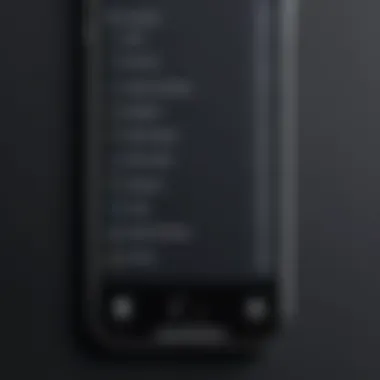
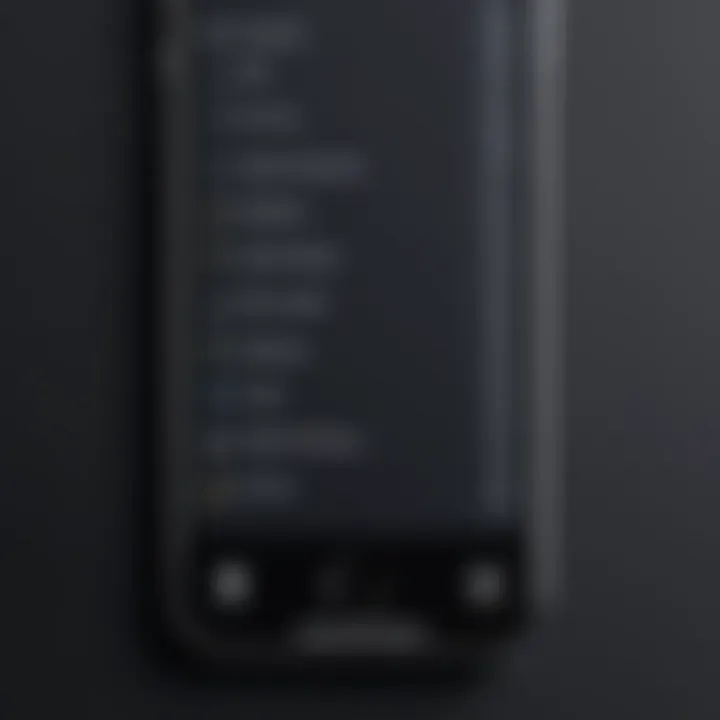
Intro
In a world dominated by technology, the tools we carry in our pockets often go unnoticed for their full potential. The ruler function on the iPhone is a prime example. Many users may not realize that their device has a built-in ruler feature, often underestimating its usefulness. This guide highlights the significance of the ruler function, detailing its utility and practical applications for everyday tasks.
Understanding how to access and utilize this feature can enhance daily routines, making it a valuable skill for those who wish to leverage technology effectively. As we explore the functionalities and precision of this tool, we aim to equip you with insights that go beyond surface-level knowledge.
Overview of the Technology
The ruler function on the iPhone operates through the device's camera and integrated sensors. This allows it to provide basic measuring capabilities directly from the screen. This built-in feature is accessible through the Measure app, which also includes a level to ensure accurate measurements. Below are some key aspects related to this technology:
Key specifications
- Compatible with iPhone models featuring iOS 12 and later.
- Uses augmented reality (AR) technology to enhance measurements.
- Measures in both metric and imperial units.
Unique selling points
- Instant access without the need for third-party apps.
- Combines measurement with additional functionality like a level.
- User-friendly interface designed for quick navigation.
"The ruler function blends simplicity and technology, reflecting how miniature tools can facilitate complex tasks."
Design and Build Quality
The design of the iPhone's ruler function is minimalistic yet effective. Its interface is intentionally straightforward, facilitating quick measurements without unnecessary distractions. The ruler itself is displayed as a digital representation on the screen, optimized for easy reading and interaction.
Material used
Being a software feature, the ruler function does not utilize physical materials. However, it relies on the iPhone's camera and sensors to create a virtual measuring tool that feels tangible to the user.
Ergonomics and usability
The ruler function is designed for seamless integration with the iPhone's overall user experience. Its ergonomic approach means that users can easily access and utilize it during various activities - whether they need to measure a piece of furniture, check the length of a project, or align objects in their environment. The touch interface allows for intuitive interaction, making it suitable for people of all ages.
Prelude to the Ruler Feature on iPhone
The ruler feature available on the iPhone represents a significant advancement in digital tools that serve practical purposes for everyday users. In this article, we delve into its functionalities, applications, and potential limitations, allowing users to fully understand how to leverage this often overlooked feature. The inclusion of a ruler in a smartphone demonstrates the continual movement towards providing multifunctional devices that cater to diverse needs. By understanding the specifics, users can appreciate how technology blends with daily endeavors, making tasks simpler and more efficient.
Historical Context of Measurement Tools
Measurement tools have a rich history that dates back to ancient civilizations. The earliest tools were rudimentary, often relying on natural objects such as sticks or stones. As societies evolved, so did the need for more precise measurement. The Egyptians utilized measuring rods while the Greeks created units that influenced modern systems.
Over centuries, standardized measuring units emerged, creating a foundation for construction, trade, and daily life. The transition from physical tools to digital devices marked a new era. With the development of smartphones, the concept of measurement expanded beyond traditional means into the digital realm.
Evolution of the Ruler in Digital Apps
With the increase in smartphone usage, applications for measurement took form. Initially, these applications replicated traditional tools. However, as technology advanced, features grew more sophisticated. The iPhone's ruler application enhances the user experience by integrating augmented reality. This innovation allows users to visualize measurements in real-time, improving accuracy and reducing errors.
The shift from analog to digital signifies a movement towards convenience. Users can access measurement tools instantly without needing physical items. This evolution demonstrates a continual adaptation to user demands, highlighting the increasing role of technology in simplifying tasks that were once manual and time-consuming.
The evolution of measuring tools reflects not only advancements in technology but also users' needs.
Overall, the ruler feature on the iPhone is the direct result of this historical journey and evolution, transforming how individuals approach basic tasks with precision.
Accessing the Ruler on iPhone
Understanding how to access the ruler function on an iPhone is crucial for users who wish to utilize this feature effectively for various tasks. The ruler function provides quick and easy access to measurements, enhancing the capability to perform projects, express dimensions, or assist in various everyday situations. With the increasing reliance on smartphones for practical utilities, having a built-in ruler can eliminate the need for traditional measuring tapes or rulers, offering both convenience and functionality. This section will guide you through locating the Measure app and setting it up for optimal use.
Where to Locate the Measure App
The Measure app is included in the iOS system, and finding it is straightforward. It can be located in the app library or on the home screen, depending on your setup. Search for "Measure" by swiping down from the middle of the home screen and typing in the app's name. If you do not see the app, it's possible it was removed from the home screen. Ensure it is not hidden in a folder and check in the app library by scrolling through the utility section.
Additionally, users can use Siri to quickly open the Measure app by saying, "Hey Siri, open Measure." This feature contributes to usability, particularly for those engaged in hands-on tasks where accessing the app through touch may be inconvenient.
Initial Setup for First-time Users
Once you have located the Measure app, the initial setup is quite simple. When you first open the app, a brief tutorial may guide you through its primary functions.
- Allow camera access: The ruler function requires access to the camera for accurate visual measurements. Ensure this permission is granted in your iPhone's settings if prompted.
- Position your device: For the best results, hold your iPhone vertically and ensure the camera view encompasses the object you intend to measure. The app utilizes augmented reality to function effectively, detecting the surfaces and dimensions around your device.
- Calibrate if necessary: Users may need to calibrate the app depending on their device. Follow on-screen instructions to ensure that the environment is set up for accurate reading.
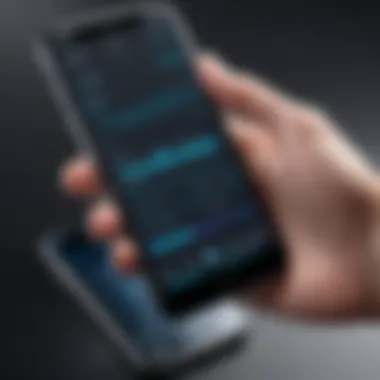
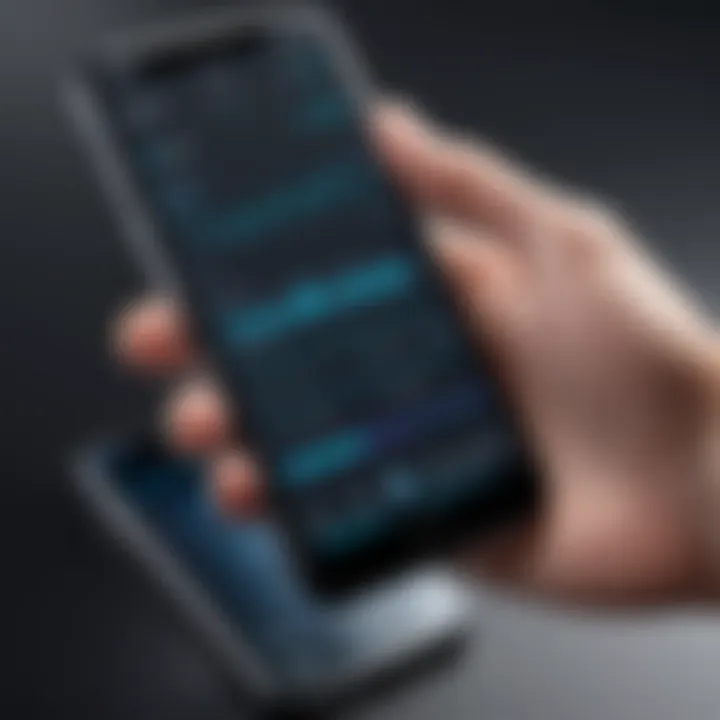
By understanding where to find the Measure app and how to set it up, you can swiftly engage with the ruler function to assist you in everyday life. This knowledge expands the potential applications of your iPhone beyond mere communication.
Functionality of the Ruler Feature
The ruler feature on the iPhone provides users with a modern approach to measurement. This functionality is crucial as it allows for quick and efficient measuring without the need for physical tools. The inherent benefits of the iPhone ruler extend beyond mere convenience; it enhances productivity, particularly in tasks that require flexibility or rapid adjustments.
Overview of Measurement Capabilities
The ruler on the iPhone is equipped to measure both length and height, utilizing the device's built-in sensors and augmented reality technology. When users point their camera at an object, the app can display height or distance in real-time. This feature can be used for everyday tasks, like measuring furniture for a new space or determining the length of an object without needing a tape measure. The measurement capabilities also include:
- Display of multiple measurement units: Users can switch between metric and imperial units with ease.
- Ability to measure irregular shapes: The ruler can be adjusted to suit the contours of non-linear items.
- Precision indicators: The user interface indicates exact measurements, helping to ensure accuracy even in complex situations.
Understanding the User Interface
The design of the ruler interface is intentionally user-friendly. Upon opening the Measure app, users are greeted with a straightforward layout. Key elements include a measurement display panel and a real-time camera viewfinder. Users can quickly tap to take measurements, with clear prompts guiding them through the process. The simplicity in navigating this app is a significant advantage, minimizing learning time and promoting effective use.
Some noteworthy elements of the user interface include:
- Instant feedback: Measurements are shown immediately, allowing for quick adjustments.
- Clear icons and instructions: Users can intuitively understand the function of each button or option.
- Accessibility features: The design considers users with disabilities, making the ruler app inclusive for broader audiences.
Calibrating the Ruler for Accurate Measurements
Accuracy in measurements is vital, especially in professional contexts. Calibrating the ruler within the iPhone is straightforward. Users are prompted to follow simple instructions to ensure precision. Calibration involves positioning the iPhone flat on a level surface and aligning it with the object being measured.
To maintain accuracy, it is recommended to:
- Re-calibrate regularly, especially after any software updates.
- Keep the lens clean to avoid any interference during measurements.
- Ensure good lighting conditions, as this significantly affects sensor performance.
Accurate measurements depend on proper calibration and environment.
Incorporating the ruler functionality into everyday tasks can enhance how users interact with their physical environment, simplifying projects that once required more time and effort. By understanding the full capabilities and operations of this feature, users can maximize the benefits of the iPhone's ruler app.
Practical Applications of the Ruler
The ruler feature on iPhone serves many practical purposes, making it an indispensible tool for various everyday tasks. This feature enhances convenience and efficiency in measuring items accurately. Whether it is for home improvement projects, art endeavors, or educational needs, the ruler function has distinct applications across different domains. Understanding these applications is essential for maximizing the value of this often underutilized tool.
Home Improvement Tasks
In home improvement, the ruler function can be immensely beneficial. It allows users to take precise measurements of spaces, objects, and more. This digital ruler enables one to check dimensions before purchasing new furniture. For instance, when evaluating whether a sofa will fit in a specific area of one's living room, using the ruler can save time and prevent costly mistakes.
Additionally, when it comes to DIY projects, measuring lengths accurately is crucial to achieve the desired outcome. Homeowners may find themselves needing to measure walls for paint or wallpaper. The ruler feature ensures that the measurements taken are not only simple but also accurate. This improves overall project quality.
"Accurate measurements can make or break a home project. Digital tools like the iPhone's ruler provide a quick solution."
Art and Design Uses
Artists and designers frequently need to measure dimensions and proportions. The iPhone’s ruler feature can be utilized in sketching, designing layouts, or even framing artwork. Whether a graphic designer needs to ensure correct scaling or an artist desires to maintain proportions, this tool provides a straightforward and portable solution. It allows creators to measure aspects directly from their device, promoting seamless workflow by eliminating the need for a physical ruler.
Furthermore, the ability to measure digital canvases or scanned images enhances creativity by ensuring that dimensions remain true to artistic vision without deviation. Designers can also gain insight into how elements will look in relation to each other before finalizing their work.
Educational Applications
In educational contexts, the ruler functionality can aid students in a variety of subjects. Subjects like mathematics and geometry, for example, benefit greatly from having a digital measurement tool at hand. Students can ensure accuracy when solving problems that involve measurement, thereby solidifying their understanding of concepts.
Teachers can also utilize the ruler feature in classrooms for hands-on activities, bringing a modern twist to traditional teaching methods. By engaging with technology, students may retain information better and enhance their learning experiences. Tools such as the iPhone ruler add an element of practicality, making lessons more applicable to real-world situations.
Advantages of Using an iPhone Ruler
The ruler function on the iPhone offers various advantages that enhance both everyday tasks and specialized activities. Understanding these benefits can help users fully leverage the capabilities of this feature. This section will cover two primary aspects: convenience and portability, as well as the integration with other iPhone features.
Convenience and Portability
One of the standout advantages of using the ruler function on an iPhone is its convenience. Unlike traditional rulers, which require physical storage and can be easily misplaced, the digital ruler is always accessible on your device. This means that anyone with access to an iPhone can measure objects at any time, making it a practical tool for spontaneous needs. When out and about, carrying a physical ruler is often impractical. The iPhone, however, is likely already in your pocket, eliminating the need for additional tools.
In addition, the iPhone's ruler function is equipped with a user-friendly interface that allows for quick measurements. The ability to tap and drag to measure length simplifies the process, which can be especially handy during home improvement projects or when shopping for furniture.
Moreover, the accuracy of digital measurements is noteworthy. Although there are concerns regarding precision, the iPhone's technology allows it to deliver satisfactory results for most everyday applications. Many users find that the combination of convenience and portability has transformed how they approach measuring tasks in their daily lives.
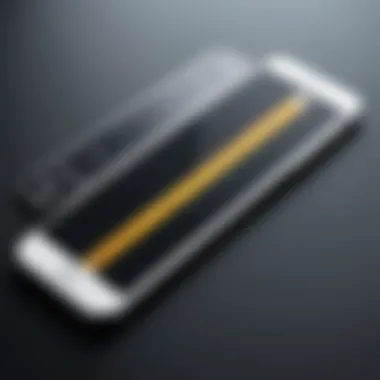
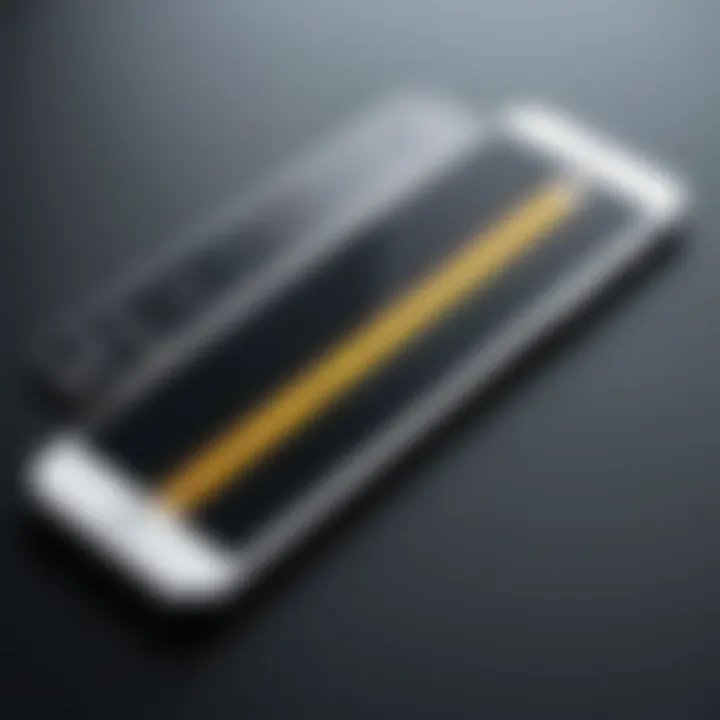
Integration with Other iPhone Features
The iPhone ruler does not operate in isolation; it integrates seamlessly with other features of the device. This interconnectedness enriches the user experience significantly. For instance, users can take advantage of the camera function to overlay measurements on images. This is particularly useful in design and architecture, where visual placements can be assessed quickly and easily.
Another benefit is how the ruler function works in tandem with the Augmented Reality (AR) capabilities of the iPhone. The Measure app, which houses the ruler feature, can detect horizontal and vertical planes, allowing users to measure spaces in real-time while viewing them through their screen. This AR capability allows for a more immersive measurement experience, giving users a clearer understanding of dimensions and spatial relationships.
"The ability to integrate measuring tools with advanced features like AR transforms everyday tasks into effortless endeavors."
By capitalizing on these advantages, users can optimize their measurement tasks, enriching both personal and professional projects.
Limitations of the Ruler Feature
The ruler functionality on iPhone offers a unique advantage for users seeking an easy method for measuring objects. However, it is essential to consider the limitations inherent in this technology. Understanding these limitations provides context on when to rely on digital measuring tools versus traditional methods. Here, we will explore the primary concerns regarding accuracy, measurement range, and their implications on the user experience.
Accuracy Concerns
Accuracy is a key aspect of any measuring tool. The ruler feature on the iPhone uses augmented reality to estimate dimensions. While it can be quite effective in many scenarios, it is not without its faults. Factors such as uneven lighting, reflective surfaces, or obstructions can easily impair the accuracy of measurements. The iPhone relies heavily on its camera and sensors to gauge distances, which can introduce errors.
Users should be aware that while the ruler app can yield satisfactory results for rough estimates, it is not suitable for situations requiring precise measurements. For example, if you need to measure the length of a piece of furniture to fit it into a space, it might be prudent to have a traditional tape measure as a backup.
In some case studies, the ruler function has been reported to vary in accuracy based on the size of the object being measured. Smaller items or those with complex shapes may not register accurately. This lack of precise measurement can lead to frustration, especially in critical projects.
Limitations in Measurement Range
The ruler feature also has its limitations concerning measurement range. The iPhone’s ruler function typically works best within a limited distance. It is calibrated for measuring objects from a few centimeters to a few meters away. Beyond this range, the accuracy diminishes significantly.
Many users may find themselves in situations where they need to measure larger spaces, such as a living room or yard. In such instances, relying solely on the iPhone’s ruler feature can be impractical. Traditional measuring tools, such as a laser distance meter or a 25-foot tape measure, would provide better results.
Moreover, attempting to measure something that exceeds the visual field of the camera can lead to challenges. The iPhone might struggle to focus properly, resulting in inaccurate readings. Thus, while the ruler function is handy for smaller household tasks, it is not designed for extensive measuring projects.
"The digital ruler simplifies basic measurements but it should not be the only tool in your kit for more complex tasks."
These limitations highlight the necessity of understanding the boundaries of the iPhone's ruler feature. Users must balance convenience with precision to select the most appropriate measuring tools based on the task at hand.
Tips for Maximizing the Ruler's Functionality
The ruler function on the iPhone presents users with a remarkable tool for precise measurements. However, to fully benefit from its capabilities, one must understand specific strategies that enhance the usability and accuracy of this feature. Below, we delve deeper into two important aspects: using multiple measurements for accuracy and maintaining device calibration. Each tip provides a more grounded approach for both casual and frequent users of the ruler function.
Using Multiple Measurements for Accuracy
Accuracy in measurement is vital, particularly when precision is needed for tasks ranging from home improvement to crafting. The ruler feature on the iPhone offers a flexible method to achieve reliable results by taking multiple measurements.
- Take Reference Points: When measuring, consider identifying multiple reference points along the length. For example, measure a distance from one end, and then measure from the other side. Doing this minimizes the chances of error that might arise from single-point measurements.
- Average Your Results: If discrepancies occur between your measurements, calculate an average. This practice helps to balance out any minor errors due to angle or position of the device during measurement.
- Use Landmarks: Align your measurements with physical landmarks in your environment. This can provide visual references that ensure consistency when repeating measurements. For instance, placing the ruler on a straight edge or near a wall can improve stability and decrease measurement error.
Using multiple measurements not only increases confidence in the results but also makes it easier to tackle tasks requiring high levels of accuracy.
Maintaining Device Calibration
Calibration is crucial for ensuring the iPhone’s ruler feature remains precise. Without regular calibration, measurements may drift over time, leading to inaccurate results. Here's how to ensure your device stays calibrated:
- Regular Calibration Checks: It is a good practice to check the calibration at intervals, especially after significant drops or changes in temperature. To recalibrate, follow the steps outlined in the Measure app, which often includes placing the device flat on a surface.
- Avoid Obstructions: Ensure there are no items obstructing the device's sensors when taking a measurement. This can introduce errors. Clear surfaces enhance the ruler's ability to detect edges accurately.
- Updates: Keep your iPhone updated. Software updates often come with performance improvements that include enhancements to measurement accuracy. Ensure that Automatic Updates are turned on in your settings.
Your iPhone's ruler app is a powerful tool that can assist in everyday tasks. Taken together, these strategies help optimize the ruler's functionality, fostering greater confidence in its measurements.
By adhering to these tips, users can vastly improve their experience with the ruler function, ensuring greater accuracy and reliability in their measurements.
Comparative Analysis with Traditional Measuring Tools
In this section, we delve into how the ruler function on the iPhone compares to traditional measuring tools. Understanding the differences between these two methods not only highlights the evolution of measurement techniques but also assists users in making informed choices about their measuring needs. Both digital and physical tools have their advantages, but the application context can dictate which is preferable.
Physical Rulers vs. Digital Rulers
Physical rulers have been the cornerstone of measurement for decades. They are simple devices made from materials like plastic or wood, featuring clear markings for various units. Their strength lies in their ease of use. There’s no need for devices or calibration; just align the edge with the object being measured. Some require no power and can function even in remote areas unrelated to technology. However, physical rulers are limited by their size and material. For instance, measuring larger objects becomes impractical.
On the contrary, digital rulers, like the iPhone's ruler function, bring versatility and modern conveniences. Using the Measure app, users can quickly measure both length and height using augmented reality technology.
Key Benefits of Digital Rulers:
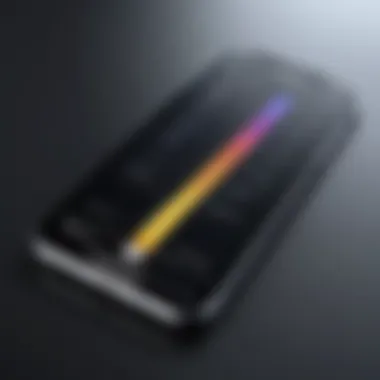
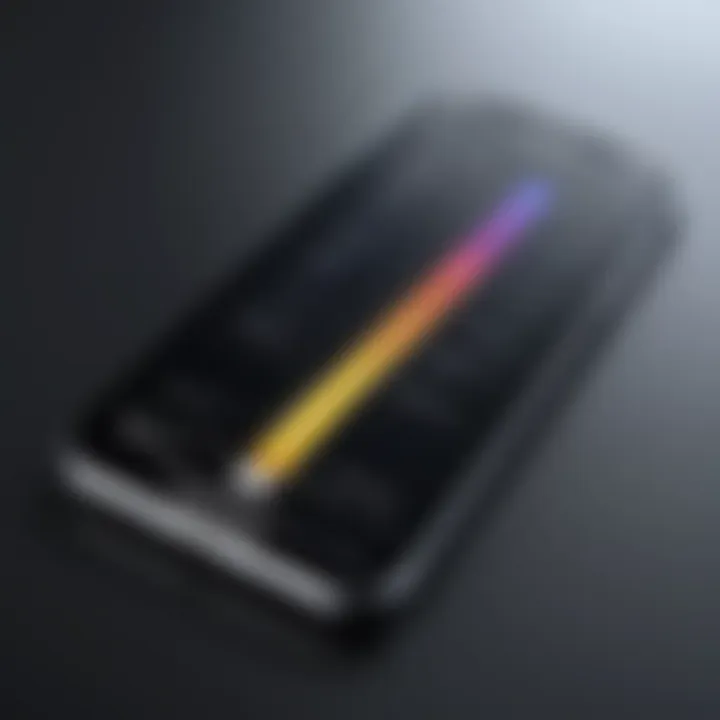
- Instant Feedback: Measurements are displayed in real-time, reducing the chance of error associated with manual readings.
- Versatile Features: The app can perform functions such as saving measurements, which is a challenge for physical tools.
- Space Efficiency: Digital rulers do not need physical storage; they reside within the smartphone.
Nevertheless, there are limitations with digital tools. They rely on the device's camera and may yield inaccurate measurements if the object is not within the camera's focal range or not properly centered in the viewfinder.
Consumer Preferences in Measurement Tools
Consumer preferences in measurement tools vary significantly, influenced by factors like convenience, accuracy, and intended use. Many tech-savvy individuals prefer digital tools for their ease of access and functionality. The ability to measure quickly without the need for physical tools appeals to those who lead busy lives.
However, traditional measuring tools still hold a significant place in many users’ daily practices. Craftsmen, artists, and professionals often favor physical rulers for their reliability. Considerations influencing consumer preference include:
- Type of Measurement Required: Precision tasks often require traditional methods.
- User Experience: Individuals comfortable with technology may find digital solutions preferable due to their user-friendly interfaces.
- Context of Use: In some settings, such as construction sites or outdoor environments, having a physical tool is sometimes more practical than relying on a smartphone.
Ultimately, it comes down to personal preference. Both methods showcase distinct advantages and limitations. Understanding their functionalities can guide users to choose the most appropriate measuring tool for their specific projects or tasks.
User Testimonials and Case Studies
User testimonials and case studies serve as critical components in understanding the practical utility of the ruler feature on the iPhone. Their significance comes from offering real-world insights, demonstrating how everyday individuals and professionals exploit digital measurement tools. These narratives not only validate the accuracy and functionality of the ruler but also provide relatable context for potential users.
Highlighting user experiences emphasizes the practical advantages and shortcomings of the feature. It showcases diverse applications, ranging from casual tasks in daily life to more specialized functions in various professions. The integration of these testimonials contributes to a more comprehensive evaluation of the ruler's effectiveness, guiding potential users in their decision-making process.
Analyzing what various users find beneficial or problematic can inform developers about needed improvements or new features. Thus, feedback from actual users helps shape future developments, ensuring that the ruler function evolves alongside its audience's needs and preferences.
"Utilizing the ruler feature on my iPhone has made my home projects easy and accurate. It's quick, portable, and always at my fingertips." - A satisfied user.
Everyday Users: Success Stories
Everyday users share compelling success stories about utilizing the iPhone's ruler feature. Many individuals discover its utility during common tasks, such as measuring furniture for fitting in rooms or ensuring that home decor aligns correctly on walls.
- Convenient Home Projects: One user noted their satisfaction while using the ruler to measure a window for new curtains. The digital tool proved effective, allowing them to save time and effort compared to using a traditional tape measure.
- Crafting and DIY Enthusiasts: Another example comes from a crafting enthusiast who found the ruler feature invaluable for precise measurements of materials for projects. They reported it reduced the effort of switching between multiple tools and made the measuring process seamless.
These testimonials illustrate the ruler's strength in practical applications. Users appreciate the immediacy and ease of access provided by their devices, making it an essential tool for daily tasks. Each success story underlines the potential for transforming mundane tasks into more efficient processes through technology.
Experts' Opinions on Digital Measurement
Expert opinions on digital measurement tools, especially the ruler function on iPhone, lend credibility to the technology and its application in various fields. Professionals point out several key benefits of integrating this feature into everyday use.
- Precision and Accessibility: Experts argue that digital tools can offer a level of precision that traditional measuring methods may lack. This advantage becomes more apparent in fields requiring exact measurements, like architecture and design.
- User-Friendly Interface: They also note the intuitive nature of mobile apps, including the ruler function, which makes technology accessible to those who might not be familiar with traditional measurement techniques. The ease of use empowers users to engage in tasks with confidence.
- Potential for Integration: Some experts recognize the ruler's potential for integration with other apps, allowing for seamless transitions between measuring and planning in projects. This connectivity can enhance productivity in professional environments.
Overall, experts emphasize the importance of adapting to digital methods. They underscore that, despite some limitations, measuring tools like the iPhone's ruler feature represent technological advancement, encouraging users to embrace these changes for improved efficiency.
Future Developments in Measurement Apps
The landscape of measurement applications is constantly changing. This section focuses on the anticipated advancements that may significantly enhance how we use the ruler function on our iPhones. With technology evolving rapidly, it is crucial to examine how these innovations can improve user experience, accuracy, and integrate with other tech features in our daily lives.
Technological Innovations on the Horizon
The future of measurement apps may present several technological innovations designed to offer improved functionality and user engagement. Some of these expected advancements include:
- Augmented Reality Enhancements: The integration of augmented reality (AR) could refine the measurement experience. Users might measure surfaces or objects more naturally by overlaying digital measurement tools onto physical ones.
- Artificial Intelligence Integration: AI can analyze user measurements for trends and suggestions. For instance, if a user frequently measures spaces for furniture, the app could recommend items that best fit their measurements and preferences.
- Precision Improvements: Current measurements can sometimes face challenges in accuracy. Future updates might introduce better algorithms to enhance precision when using the ruler function, even in less than ideal lighting conditions.
- Multi-Device Synchronization: Users often switch between devices. Future apps may offer seamless synchronization across different gadgets, allowing measurements taken on one device to be accessible on another, improving ease of use and organization.
As these technological innovations develop, they will provide users with capabilities that go beyond simple measurements. The focus will expand towards a more immersive, intelligent, and user-friendly interface.
Anticipating Changes in User Interaction
As measurement apps advance, the way users interact with these tools will likely change as well. Here are several aspects to consider:
- User-Centric Design: Future apps may adopt designs that prioritize user experience. Simplified navigations and intuitive layouts would make it easier for all users, regardless of their technical proficiency, to utilize measurement features.
- Voice Commands: Integrating voice recognition could allow users to take measurements hands-free. This feature will be beneficial while engaging in tasks where one’s hands are occupied.
- Real-Time Feedback: Apps might evolve to give immediate feedback based on measurements taken. Users could receive alerts or suggestions if a measurement is outside a specified range, enhancing overall efficiency.
- Customizable Features: Users may have the ability to customize their measurement settings. Tailoring preferences according to specific tasks or projects might greatly improve how measurements are utilized.
In summary, the anticipated changes in user interaction will aim to make the ruler function on iPhones more accessible, efficient, and integrated into daily workflows. These developments will not just enhance accuracy but will likely transform how tasks are approached across various domains.
The End
The conclusion serves as a pivotal component in this article focusing on the ruler function available on the iPhone. This section emphasizes the overall importance of understanding how to effectively utilize the ruler feature. As we have explored, the ruler tool provides users with convenience, accuracy, and versatility in various applications, which can significantly enhance productivity in daily tasks.
Recap of Key Points
In this article, we delved into several key aspects:
- Accessing the Ruler: We provided a step-by-step guide on how to locate and set up the Measure app, ensuring ease of access for first-time users.
- Functionality: We discussed how the ruler feature works, including a breakdown of the user interface and methods to calibrate for precise measurements.
- Practical Applications: Various real-world uses of the ruler were explored, showing its relevance in home improvement, art, design, and education.
- Advantages and Limitations: The discussion highlighted the benefits of using a digital ruler while also addressing concerns about its accuracy and measurement range.
- Tips for Maximizing Functionality: Suggestions were given on how to use the tool effectively, including maintaining device calibration and employing multiple measurements when necessary.
- Future Developments: We briefly touched upon potential technological innovations that could enhance user interaction with measurement apps.
By synthesizing these points, readers can appreciate how the ruler function on the iPhone is not only a modern tool for measurement but also enhances the user's overall experience.
Final Thoughts on the Role of Digital Rulers
Digital rulers, such as the one embedded in the iPhone, represent a significant leap in how measurements are taken in our tech-driven world. They merge usability with functionality, making them indispensable for various applications. This technology enables immediate access to measurement tools, bridging the gap between traditional techniques and modern needs.







